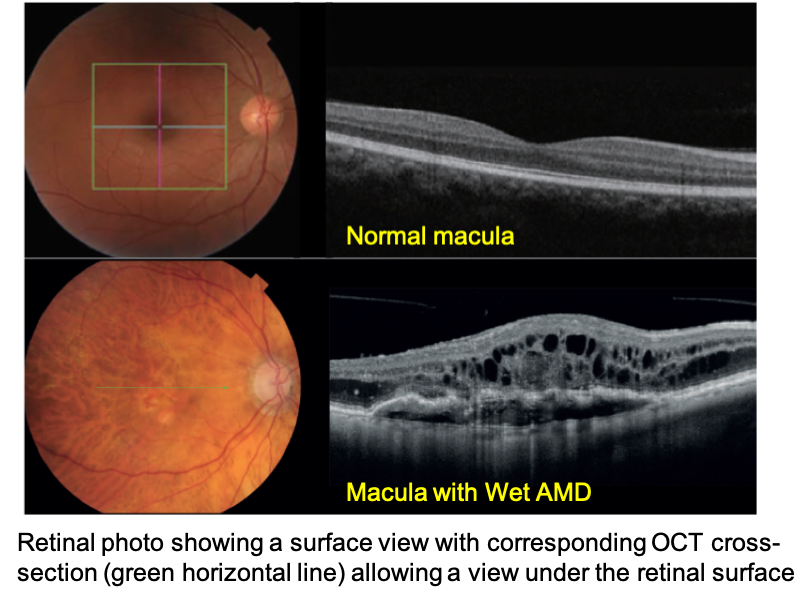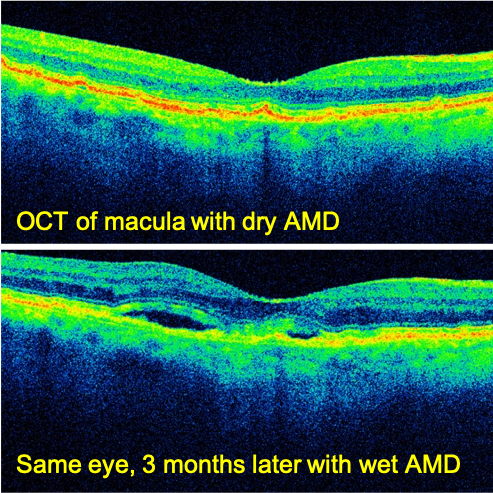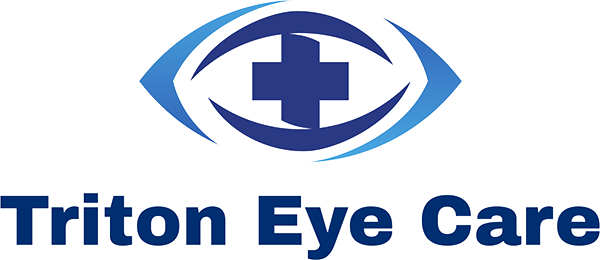Retinal Photo
 Determining with accuracy the health of the retina and optic nerve are critical in eye care. Triton Eye Care employs the Topcon Maestro 2 for detailed imaging of the inside of the eye. Two types of imaging are obtained simultaneously with the Maestro. First, a photo of the retina is taken, which allows for a surface view of the back of the eye. While Dr. Morgan also takes a live look at the back of your eye during an exam, the views can only be momentary, or the light used would become uncomfortable. With the retinal photo, a quick flash of light captures an image of the back of the eye that can be more easily studied. The photo can also be used to educate you on your eye health. The photo is stored in your medical record for reference, allowing for easy future comparison.
Determining with accuracy the health of the retina and optic nerve are critical in eye care. Triton Eye Care employs the Topcon Maestro 2 for detailed imaging of the inside of the eye. Two types of imaging are obtained simultaneously with the Maestro. First, a photo of the retina is taken, which allows for a surface view of the back of the eye. While Dr. Morgan also takes a live look at the back of your eye during an exam, the views can only be momentary, or the light used would become uncomfortable. With the retinal photo, a quick flash of light captures an image of the back of the eye that can be more easily studied. The photo can also be used to educate you on your eye health. The photo is stored in your medical record for reference, allowing for easy future comparison.
OCT
The second type of imaging captured is called Optical Coherence Tomography, or OCT. An OCT image allows what lies beneath the surface to be seen as well. Why is this important? Well, imagine this scenario…
You are navigating a boat down a jungle river. You come around a bend and see a tree sticking out of the water. You don’t want to hit the tree, so you steer the boat in an attempt to get around it. What you can’t see is that the tree actually fell from shore, and you steered the boat right into its thick trunk, which is submerged below the water. Hitting the trunk, the boat capsizes, and you are thrown from the boat into the water. Being in the jungle, there are all kinds of hungry, dangerous creatures such as piranhas and crocodiles in the water. If only you could have seen below the surface of the water! Certainly, you would have steered the boat around the opposite side of the tree…
Hence, the importance of OCT technology during an eye exam. Sometimes, things may appear normal on the surface of the retina and optic nerve when in fact, they are not. Early macular degeneration, early macular edema from diabetes, early thinning of optic nerve tissue that can lead to glaucoma, and other insidious conditions can all be uncovered in a timely manner. Early detection of eye disease allows for prevention and treatment strategies to be promptly undertaken to preserve vision.
OCT is a non-invasive, non-contact procedure that doesn't require preparation from the patient. There is no exposure to radiation since unlike images obtained by an x-ray, CT scan, or MRI, the machine simply uses light to obtain the images. The patient sits in front of the OCT instrument,  a couple of bright flashes like a normal camera flash go off, and the images are available for viewing within a minute.
a couple of bright flashes like a normal camera flash go off, and the images are available for viewing within a minute.
OCT and AMD
For patients with Age-related macular degeneration (AMD) , OCT is an invaluable tool to monitor for the development of wet AMD. While all patients start out with the dry form of AMD, some will progress to the wet form. Wet AMD occurs when new blood vessels grow under the retina, which don’t become visible on the retinal surface until they have leaked blood and affected vision. Periodic monitoring of dry AMD with OCT allows for early detection of wet AMD, many times before the patient is aware of any visual change. When caught early, wet AMD can be effectively treated with medication to prevent further abnormal blood vessel growth, preserving vision.
OCT and Diabetes
According to the US National Institute of Health (NIH), 30.3 million people have diabetes, 24 percent of which are undiagnosed. Additionally, 107.2 million American adults have prediabetes. Many times, diabetes is discovered during an eye exam, and testing with a retinal photo and OCT (performed simultaneously with the Maestro 2 is invaluable in making the diagnosis. This allows for prompt referral to your physician for evaluation of treatment. For those diagnosed with diabetes, an essential part of your treatment is a yearly eye exam to monitor for the development or progression of diabetic retinopathy , of which the Maestro 2 is an integral part. After your exam, Dr. Morgan will send a detailed report to your doctor.
OCT and Glaucoma
Another common use of the OCT is for monitoring and managing glaucoma. Our office usually takes initial images of the optic nerve, and the OCT analyzes and compares these images to a vast database of age-matched healthy control patients. The OCT will usually be repeated every year to follow any changes or progression over time.
The advent of OCT has revolutionized the way we evaluate the retina because we can now detect subtle findings not otherwise easily seen during clinical exams. This makes the OCT one of the most valuable tests we can do in our office.


